Activities, Writings and Resources on Evolution
The Board of Directors of Sigma Xi, The Scientific Research Society strongly supports the teaching of evolution in schools, and provides this portal to information on the theory of evolution and its teaching.
Sigma Xi Efforts
2006-2007 Distinguished Lectures
Virginia Butler and Clark Larsen offered talks on aspects of evolution.
Society Signs Amicus Brief in Georgia Case
Sigma Xi, The Scientific Research Society, acting in support of the principle of evolution by natural selection, is an official signatory to the amicus curiae ("friend of the court") submitted June 10, 2005 in the case of Selman v. Cobb County School District.
The Selman Amicus Brief urges the U.S. appeals court to uphold a lower court decision that evolution "warning labels" required in Cobb County, Georgia public school textbooks were unconstitutional. Sigma Xi joined 55 other scientific societies in signing the brief.
Sigma Xi Board Endorses Position Statement
The Board of Directors of Sigma Xi, The Scientific Research Society has endorsed a statement supporting the teaching of evolution in schools:
The contemporary theory of biological evolution is one of the most robust products of scientific inquiry. It is the foundation for research in many areas of biology as well as an essential element of science education. To become informed and responsible citizens in our contemporary technological world, students need to study the theories and empirical evidence central to current scientific understanding.
Board, Public Understanding of Science Committee Encourage Action
The Board encourages Sigma Xi members to get involved in the issue. Among the general public, there is some confusion over evolution, and controversy over how it should be taught in local schools. That confusion may stem from a gap in the public's understanding about the scientific process of discovery, how science works to further knowledge about the natural world, and what it can and cannot explain.
Scientific researchers have an opportunity to address that gap, and to inform the public about what constitutes science and what does not, by working with citizens and institutions in their communities. Sigma Xi's Public Understanding of Science Committee encourages and supports Society chapters and members to volunteer to contribute to discussions about the way evolution, and thus scientific methodology, is taught and understood.
Ayala Speaks On Being a Scientist: The Year 2000
Challenges to evolution are nothing new, of course, and if scientists are to become engaged with the issue it is important that they have a full understanding of the historical context that has shaped the current conflict. One of the most powerful and direct presentations of that context was delivered by Francisco J. Ayala, the Donald Bren Professor of Biological Sciences, University of California at Irvine, at Sigma Xi's 2000 Forum. Read the full text of Ayala's lecture, "On Being a Scientist: The Year 2000."
American Scientist Writings
Sigma Xi has published a wealth of pieces in American Scientist magazine that affirm the bedrock scientific status occupied by the theory of evolution. These include both commentaries and research reviews explaining the application of evolutionary principles. A categorized sample is included on this page; a broader collection is accessible in an Evolution Topical Index at American Scientist Online.
Origin of Life
The Origin of Animal Body Plans
Douglas Erwin, James Valentine, David Jablonski
Feature Article
March-April 1997
 For its first 3 billion years on earth, life was no larger or more sophisticated than a single cell. All of that changed when almost 600 million years ago new, multicellular life forms appear in the fossil record. Starting with simple soft-bodied creatures this evolutionary innovation culminates in the "Cambrian explosion," a burst of biological creativity unprecedented in earth's history. The Cambrian epoch saw the creation of hundreds of life forms stranger than anything humanly imaginable. Many of these animals are now extinct, but those that remained established all of the basic bodyplans of all animals that evolved since. Until recently, it was difficult to understand the biological mechanisms underlying the creation and evolution of body architectures, much less establish lines of descendence. But new discoveries in molecular biology and development, as well as new ways of analyzing genetic relationships is helping scientists reconstruct the earliest chapters in the history of life on earth.
For its first 3 billion years on earth, life was no larger or more sophisticated than a single cell. All of that changed when almost 600 million years ago new, multicellular life forms appear in the fossil record. Starting with simple soft-bodied creatures this evolutionary innovation culminates in the "Cambrian explosion," a burst of biological creativity unprecedented in earth's history. The Cambrian epoch saw the creation of hundreds of life forms stranger than anything humanly imaginable. Many of these animals are now extinct, but those that remained established all of the basic bodyplans of all animals that evolved since. Until recently, it was difficult to understand the biological mechanisms underlying the creation and evolution of body architectures, much less establish lines of descendence. But new discoveries in molecular biology and development, as well as new ways of analyzing genetic relationships is helping scientists reconstruct the earliest chapters in the history of life on earth.
First Life
Michael Russell
Feature Article
January-February 2006
 Four billion years ago, back when life began, our planet was a very different place. Earth spun more rapidly on its axis—a day lasted only four or five hours. The Moon was much closer, and giant meteorites pelted the planet. Under these conditions of constant, chaotic change, there was only one place of constancy—a warm spring in the relative safety of the deep ocean floor. There, protected from ultraviolet radiation, existed a place that never dried out, never got too hot or too cold, never became too acidic or too alkaline. Life began there, inside the membranous froth of minerals that surrounded these hydrothermal springs, and the minerals themselves catalyzed the first chemical reactions that made proteins and nucleic acids—precursors to the earliest living things. Every kind of life, including us, carries the mark of that first catalysis in the form of tiny mineral clusters at the centers of our enzymes, still doing the jobs they began so long ago.
Four billion years ago, back when life began, our planet was a very different place. Earth spun more rapidly on its axis—a day lasted only four or five hours. The Moon was much closer, and giant meteorites pelted the planet. Under these conditions of constant, chaotic change, there was only one place of constancy—a warm spring in the relative safety of the deep ocean floor. There, protected from ultraviolet radiation, existed a place that never dried out, never got too hot or too cold, never became too acidic or too alkaline. Life began there, inside the membranous froth of minerals that surrounded these hydrothermal springs, and the minerals themselves catalyzed the first chemical reactions that made proteins and nucleic acids—precursors to the earliest living things. Every kind of life, including us, carries the mark of that first catalysis in the form of tiny mineral clusters at the centers of our enzymes, still doing the jobs they began so long ago.
Other Notables:
- In Search of Permian Perpetrators, Book Review, Richard J. Twitchett, July-August 2006
- The Evolution of Hemoglobin, Feature Article, Ross Hardison, March-April 1999
- Decoding the Cambrian Radiation, Book Review, Derek E.G. Briggs, May-June 2005
- Up from the Ooze, Book Review, Gene D. McDonald, March-April 2001
Speciation
The Ecology and Evolution of Hawaiian Spider Communities
Rosemary Gillespie
Feature Article
March-April 2005
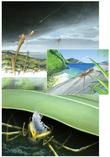 Evolutionary biologists and ecologists explain the way species are assembled in biological communities quite differently. Studies of the spiny-legged spider (Tetragnatha spp.) in Hawaii support the idea that this contention may result from the time scales on which scientists have worked. The basic ecological and evolutionary processes that generate diversity and underlie community assembly are the same: New species enter a community by colonization or evolution, species accumulate, and the assemblage approaches equilibrium with particular sets of species. In Hawaii, geology and biology have interacted to produce a fascinating diversity of spiders that provide an elegant illustration of these principles.
Evolutionary biologists and ecologists explain the way species are assembled in biological communities quite differently. Studies of the spiny-legged spider (Tetragnatha spp.) in Hawaii support the idea that this contention may result from the time scales on which scientists have worked. The basic ecological and evolutionary processes that generate diversity and underlie community assembly are the same: New species enter a community by colonization or evolution, species accumulate, and the assemblage approaches equilibrium with particular sets of species. In Hawaii, geology and biology have interacted to produce a fascinating diversity of spiders that provide an elegant illustration of these principles.
On the First Day, God Said . . .
Simon Conway Morris
Book Review
March-April 1997
 What, if anything, triggered the dramatic adaptive radiations of metazoans (organisms having differentiated tissues such as muscle and nerves) about 540 million years ago, an event colloquially referred to as the Cambrian "explosion."
What, if anything, triggered the dramatic adaptive radiations of metazoans (organisms having differentiated tissues such as muscle and nerves) about 540 million years ago, an event colloquially referred to as the Cambrian "explosion."
Author Andrew Parker's thesis is that with the invention of eyes and vision the world changed forever. Such an acute sense, dependent on the same sunlight that had powered photosynthesis for thousands of millions of years, opened the doors of animal perception and ushered in predation, protection, camouflage, pursuit, escape and, as a direct consequence, a set of radically new ecologies. At first sight it is an appealing hypothesis, but as presented it is in fact no more convincing than any of the other speculations that have been wheeled out to explain the Cambrian explosion.
Other Notables:
- Missing Links and Found Links, Marginalia, Pat Shipman, November-December 2006
- Adaptive Radiation of Darwin's Finches, Feature Article, Peter R. Grant, B. Rosemary Grant, March-April 2002
- How Species Arise, Book Review, David B. Wake, November-December 2004
Fossils
Hooke, Fossils and the Anti-Evolutionists
Keith Stewart Thomson
Column
May-June 2003
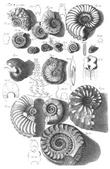 I occasionally receive notice that publications of mine on the subject of evolutionary theory have been quoted to promote an anti-evolutionist, creationist agenda: Recently it was the so-called Discovery Institute using my work in an attempt to limit the teaching of evolution in Ohio schools. At such times it is difficult to know whether to laugh or cry. These people read science so assiduously only to use it against us. But ultimately they are engaged in a deeper struggle for our hearts and minds that will never really go away: Is the universe totally explainable in scientific terms, or is there an ultimate, unknowable "mystery"?
I occasionally receive notice that publications of mine on the subject of evolutionary theory have been quoted to promote an anti-evolutionist, creationist agenda: Recently it was the so-called Discovery Institute using my work in an attempt to limit the teaching of evolution in Ohio schools. At such times it is difficult to know whether to laugh or cry. These people read science so assiduously only to use it against us. But ultimately they are engaged in a deeper struggle for our hearts and minds that will never really go away: Is the universe totally explainable in scientific terms, or is there an ultimate, unknowable "mystery"?
New Ideas About Old Sharks
Susan Turner, Randall F. Miller
Feature Article
May-June 2005
 The evolution of jaws was a crucial step in vertebrate history, but it took place so long ago that fossils from this period consist mostly of teeth and a bewildering variety of skin scales. Now an almost complete shark fossil gives paleontologists the opportunity to investigate the poorly understood transition between sharks and modern fishes and to interpret isolated fossils from a new perspective. The remarkably intact 409 million year-old example preserves the braincase, jaws, teeth and pectoral fins in the correct anatomical position. Based on this finding, the authors revise the geography of early shark evolution and question the accepted picture of shark evolution as it relates to other major fish groups.
The evolution of jaws was a crucial step in vertebrate history, but it took place so long ago that fossils from this period consist mostly of teeth and a bewildering variety of skin scales. Now an almost complete shark fossil gives paleontologists the opportunity to investigate the poorly understood transition between sharks and modern fishes and to interpret isolated fossils from a new perspective. The remarkably intact 409 million year-old example preserves the braincase, jaws, teeth and pectoral fins in the correct anatomical position. Based on this finding, the authors revise the geography of early shark evolution and question the accepted picture of shark evolution as it relates to other major fish groups.
Other Notables:
Human Evolution
A Worm's View of Human Evolution
Pat Shipman
Column
November-December 2002
 I was surprised recently to discover how much a few worms have to say about human evolution. There are many different ways of knowing in science, many different pathways to uncovering evidence, and some of them only the most ingenious among us would imagine. So it is with a project recently described in theProceedings of the Royal Society of London that focuses on the anatomy, phylogeny and genetic variability of various species of tapeworms to uncover new facts about the habits of hominids, our human ancestors.
I was surprised recently to discover how much a few worms have to say about human evolution. There are many different ways of knowing in science, many different pathways to uncovering evidence, and some of them only the most ingenious among us would imagine. So it is with a project recently described in theProceedings of the Royal Society of London that focuses on the anatomy, phylogeny and genetic variability of various species of tapeworms to uncover new facts about the habits of hominids, our human ancestors.
The Nature of Emotions
Robert Plutchik
Feature Article
July-August 2001
 What is an emotion? More than 90 definitions have been offered over the past century, and there are almost as many theories of emotion—not to mention a complex array of overlapping words in our languages to describe them. Plutchik offers an integrative theory based on evolutionary principles. Emotions are adaptive—in fact, they have a complexity born of a long evolutionary history—and although we conceive of emotions as feeling states, Robert Plutchik says the feeling state is part of a process involving both cognition and behavior and containing several feedback loops.
What is an emotion? More than 90 definitions have been offered over the past century, and there are almost as many theories of emotion—not to mention a complex array of overlapping words in our languages to describe them. Plutchik offers an integrative theory based on evolutionary principles. Emotions are adaptive—in fact, they have a complexity born of a long evolutionary history—and although we conceive of emotions as feeling states, Robert Plutchik says the feeling state is part of a process involving both cognition and behavior and containing several feedback loops.
Other Notables:
- Evo Devo Psych, Book Review, Ethan Remmel, March-April 2006
- Bones of Contention?, Book Review, Jeffrey K. McKee, November-December 2006
- A Bare-Bones Account of Human Evolution, Book Review, Derek Bickerton, September-October 2002
- We Are All Africans, Column, Pat Shipman, November-December 2003
- The Structure of the Human Brain, Feature Article, John S. Allen, Joel Bruss, Hanna Damasio, May-June 2004
- Hunting the First Hominid, Column, Pat Shipman, January-February 2002
- The Evolution of Jealousy, Feature Article, Christine R. Harris, January-February 2004
Evolution at Work
Animal Contests as Evolutionary Games
Mike Mesterton-Gibbons, Eldridge S. Adams
Feature Article
July-August 1998
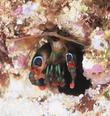 Whether it's in a dark alley or an open field, a meeting between two animals of the same species is an event that natural selection cannot pass by. The animals may ignore each other or they may fight, but modern evolutionary theory holds that there is a strategy behind their actions. The challenge for evolutionary biologists is to discover what that strategy might be. Our authors apply the logic and mathematics of game theory to account for the (often peculiar) responses of two animals when they meet face to face.
Whether it's in a dark alley or an open field, a meeting between two animals of the same species is an event that natural selection cannot pass by. The animals may ignore each other or they may fight, but modern evolutionary theory holds that there is a strategy behind their actions. The challenge for evolutionary biologists is to discover what that strategy might be. Our authors apply the logic and mathematics of game theory to account for the (often peculiar) responses of two animals when they meet face to face.
New Antibiotics and New Resistance
Carlos Amábile-Cuevas
Feature Article
March-April 2003
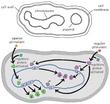 Antibiotics were treated as miracle drugs when they first became available half a century ago. But their popularity rapidly led to overuse. Over the last decade, it has become well-known that antibiotics are losing their effectiveness as bacteria evolve resistance against them and new drugs only rarely reach the market. Bacteria can acquire drug resistance in a multitude of ways, so getting around the resistance problem is not a straightforward matter. Pharmaceutical companies have just recently revived efforts to develop new antibiotics. But preventing a future in which bacteria are once again widespread killers requires more than one approach-among them, the rational use of antibiotics in health care and agriculture, improved techniques for developing new drugs and new perspectives on how to live with the infectious creatures that share the planet with us.
Antibiotics were treated as miracle drugs when they first became available half a century ago. But their popularity rapidly led to overuse. Over the last decade, it has become well-known that antibiotics are losing their effectiveness as bacteria evolve resistance against them and new drugs only rarely reach the market. Bacteria can acquire drug resistance in a multitude of ways, so getting around the resistance problem is not a straightforward matter. Pharmaceutical companies have just recently revived efforts to develop new antibiotics. But preventing a future in which bacteria are once again widespread killers requires more than one approach-among them, the rational use of antibiotics in health care and agriculture, improved techniques for developing new drugs and new perspectives on how to live with the infectious creatures that share the planet with us.
Genetic Strategies for Controlling Mosquito-Borne Diseases
Fred Gould, Krisztian Magori, Yunxin Huang
Feature Article
May-June 2006
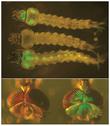 Malaria infects hundreds of millions of people each year and kills a million of them, mostly small children. It has no vaccine, and treatments are losing efficacy as the parasite evolves to resist their effect. Malaria, like several other tropical diseases including dengue fever, are spread through the bite of an infected mosquito, and public health initiatives to combat these diseases have focused on insecticides and netting with limited success. But what if mosquitoes could no longer transmit the disease? In the laboratory, scientists have succeeded in adding specific genes to the mosquito that make it unable to transmit the parasites that cause malaria or dengue. It might be possible to cause similar changes to wild mosquitoes. The tricky part would be getting the disease-blocking genes to spread to the whole population: Thousands of transgenic insects would have to breed with and eventually replace the local mosquitoes. Furthermore, adding genes to an organism generally hampers its ability to thrive, so natural selection would seem to work against the modified insects. Nonetheless, recent experiments suggest that genetically altered mosquitoes could provide a realistic solution to the problem of mosquito-borne diseases-provided that some of the large technical hurdles can be overcome. Gould, Magori and Huang describe some of the sophisticated genetic strategies that could be used to drive anti-parasite genes into a population of wild mosquitoes as well as the risks attendant in such a scheme.
Malaria infects hundreds of millions of people each year and kills a million of them, mostly small children. It has no vaccine, and treatments are losing efficacy as the parasite evolves to resist their effect. Malaria, like several other tropical diseases including dengue fever, are spread through the bite of an infected mosquito, and public health initiatives to combat these diseases have focused on insecticides and netting with limited success. But what if mosquitoes could no longer transmit the disease? In the laboratory, scientists have succeeded in adding specific genes to the mosquito that make it unable to transmit the parasites that cause malaria or dengue. It might be possible to cause similar changes to wild mosquitoes. The tricky part would be getting the disease-blocking genes to spread to the whole population: Thousands of transgenic insects would have to breed with and eventually replace the local mosquitoes. Furthermore, adding genes to an organism generally hampers its ability to thrive, so natural selection would seem to work against the modified insects. Nonetheless, recent experiments suggest that genetically altered mosquitoes could provide a realistic solution to the problem of mosquito-borne diseases-provided that some of the large technical hurdles can be overcome. Gould, Magori and Huang describe some of the sophisticated genetic strategies that could be used to drive anti-parasite genes into a population of wild mosquitoes as well as the risks attendant in such a scheme.
Other Notables:
- Foresight in Genome Evolution, Feature Article, Lynn Helena Caporale, May-June 2003
- Free Upgrades, Unfortunately, Science Observer, Elsa Youngsteadt, November-December 2006
- Have We Solved Darwin's Dilemma?, Book Review, Massimo Pigliucci, May-June 2006
- In the Twinkle of a Fly, Book Review, Rudolf A. Raff, July-August 2006
- The Dark Side of DNA, Book Review, Fred Gould, November-December 2006
- An Interview with Marc Kirschner and John Gerhart, Interview, November 2005
- Influenza, Feature Article, Robert G. Webster, Elizabeth Jane Walker, March-April 2003
- The Lion's Mane, Feature Article, Peyton M. West, May-June 2005
- Clever Tinkering, Book Review, Lewis Wolpert, September-October 2005
- How Tunas and Lamnid Sharks Swim: An Evolutionary Convergence, Feature Article, Robert E. Shadwick, November-December 2005
- The Molecular Anatomy of an Ancient Adaptive Event, Feature Article, Antony Dean, January-February 1998
- Yawning, Feature Article, Robert R. Provine, November-December 2005
Cosmology, Astronomy and Geology
Observing the Beginning of Time
Craig J. Hogan
Feature Article
September-October 2002
 The expansion of the universe was apparently kicked off by a new energy field—the inflaton—less than a second after the Big Bang. The weird repulsive gravity of the inflaton is what made the Big Bang big, and it's the reason that the universe is considerably larger than an atom. Small quantum fluctuations in the inflaton field ultimately led to the formation of everything we see today, and they also left a visible imprint on the brightness of the "cosmic background radiation"—a cold light that originated in the Big Bang and still permeates the universe today. The fluctuations are evident in slight temperature differences in the background radiation that appear as slightly hot and slightly cold blotches in the sky. These blotches are the largest structures we will ever see, but they are also faithful images of the smallest things we can ever see, single elementary quanta. High-resolution images of these blotches may ultimately reveal the quantum nature of spacetime—which, for all practical purposes, would be a view of the discrete structure from which space and time emerged.
The expansion of the universe was apparently kicked off by a new energy field—the inflaton—less than a second after the Big Bang. The weird repulsive gravity of the inflaton is what made the Big Bang big, and it's the reason that the universe is considerably larger than an atom. Small quantum fluctuations in the inflaton field ultimately led to the formation of everything we see today, and they also left a visible imprint on the brightness of the "cosmic background radiation"—a cold light that originated in the Big Bang and still permeates the universe today. The fluctuations are evident in slight temperature differences in the background radiation that appear as slightly hot and slightly cold blotches in the sky. These blotches are the largest structures we will ever see, but they are also faithful images of the smallest things we can ever see, single elementary quanta. High-resolution images of these blotches may ultimately reveal the quantum nature of spacetime—which, for all practical purposes, would be a view of the discrete structure from which space and time emerged.
The Star-Formation History of the Universe
Alan Heavens
Feature Article
January-February 2005
 Modern cosmologies suggest that the universe was quite dark for much of its first billion years. During these dark ages, the universe contained clouds of hydrogen gas, but little else—the first stars did not form until several hundred million years had passed. Once the cosmic star-making machinery got going, however, it churned out giant balls of burning gas with a passion—there are now thought to be 1021 stars in the observable universe. After studying the ages of the stars in nearly 100,000 galaxies, astrophysicist Alan Heavens estimated the rate at which the universe formed stars at different periods in its history. His results challenge the traditional view and suggest that large and small galaxies may have formed most of their stars at different times in the past.
Modern cosmologies suggest that the universe was quite dark for much of its first billion years. During these dark ages, the universe contained clouds of hydrogen gas, but little else—the first stars did not form until several hundred million years had passed. Once the cosmic star-making machinery got going, however, it churned out giant balls of burning gas with a passion—there are now thought to be 1021 stars in the observable universe. After studying the ages of the stars in nearly 100,000 galaxies, astrophysicist Alan Heavens estimated the rate at which the universe formed stars at different periods in its history. His results challenge the traditional view and suggest that large and small galaxies may have formed most of their stars at different times in the past.
How Do Supercontinents Assemble?
J. Brendan Murphy, R. Damian Nance
Feature Article
July-August 2004
Over the past 3 billion years, at least six supercontinents have assembled and split apart in what some earth scientists refer to as the supercontinent cycle. About that much there is general agreement; just how this process works, however, has been a source of considerable controversy. One camp would have the continents spread apart and reunite much like an accordion. Another thinks that land masses break up and circumnavigate the globe before getting back together again. The resolution lies in establishing the crystallization dates of oceanic crust that was generated or consumed during continental movement, but "seeing" back further than one cycle has proved difficult. The authors have used a unique radioactive-isotope ratio to determine that both tectonic processes have likely been at play.
Other Notables:
- A Grand Enigma, Book Review, Robert H. Webb, March-April 2006
- The Formation and Evolution of the Milky Way, Feature Article, Cristina Chiappini, November-December 2001
- An Argument for the Cometary Origin of the Biosphere, Feature Article, Armand H. Delsemme, September-October 2001
- A Tour of Geological Spacetime, Column, Philip Morrison, March-April 2004
In Context: The Conflict and its Personalities
Creationism's Geologic Time Scale
Donald U. Wise
Feature Article
March-April 1998
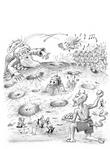 Few scientists have read the literature of the "creation science" movement. Donald Wise, in an attempt to understand the alternative models of earth history proposed by creationists, has managed to piece together a geologic time scale based on the literature. Only by understanding the underlying ideas, history and assumptions of "creation science," Wise argues, can scientists effectively maintain the distinctions between science and religion and counteract efforts by fundamentalists to bring the Bible into public schools as a science textbook.
Few scientists have read the literature of the "creation science" movement. Donald Wise, in an attempt to understand the alternative models of earth history proposed by creationists, has managed to piece together a geologic time scale based on the literature. Only by understanding the underlying ideas, history and assumptions of "creation science," Wise argues, can scientists effectively maintain the distinctions between science and religion and counteract efforts by fundamentalists to bring the Bible into public schools as a science textbook.
Laying Bare Darwin's Secrets
Keith Stewart Thomson
Book Review
January-February 2003
 Darwin's revisions to the Origin eventually compromised it, so keen was he to respond to critics. Not only did he defend, he attacked. It is hard to know which to admire more, the skill with which he and his band of disciples went about preparing the ground for the Origin (shrewdly distributing advance copies to potential opponents, for example) or the zeal with which they all, after publication, set about savaging (not always fairly) the critics. Although we are familiar with Huxley's role as Darwin's bulldog, Darwin was quite capable of being his own rottweiler. When a paper by his son Francis was rejected by the Royal Society, Darwin ruthlessly counterattacked in Nature. In 1873, St. George Mivart got into a spat with Darwin's son George over a sort of proto-eugenics. Darwin nearly went to court on behalf of George (who was in the wrong) and later blackballed Mivart for membership in the Athenaeum.
Darwin's revisions to the Origin eventually compromised it, so keen was he to respond to critics. Not only did he defend, he attacked. It is hard to know which to admire more, the skill with which he and his band of disciples went about preparing the ground for the Origin (shrewdly distributing advance copies to potential opponents, for example) or the zeal with which they all, after publication, set about savaging (not always fairly) the critics. Although we are familiar with Huxley's role as Darwin's bulldog, Darwin was quite capable of being his own rottweiler. When a paper by his son Francis was rejected by the Royal Society, Darwin ruthlessly counterattacked in Nature. In 1873, St. George Mivart got into a spat with Darwin's son George over a sort of proto-eugenics. Darwin nearly went to court on behalf of George (who was in the wrong) and later blackballed Mivart for membership in the Athenaeum.
Other Notables:
- An Interview with Michael Shermer, October 2006
- An with Daniel Dennett, February 2006
- Darwin on Display, Book Review, Robert Dorit, March-April 2006
- On the Perils of Publishing, Book Review, Bettyann Holtzmann Kevles, November-December 2006
- Being Stalked by Intelligent Design, Column, Pat Shipman, November-December 2005
- The Steve Wars, Science Observer, Margaret Pizer, May-June 2003
- Science and Religious Fundamentalism in the 1920s, Feature Article, Edward B. Davis, May-June 2005
- Through a Glass, Darkly, Book Review, Michael Ruse, November-December 2003
- The Evolution of a Naturalist, Book Review, Oren Solomon Harman, September-October 2004
- An Elder's View of a Young Theory, Book Review, David Sloan Wilson, March-April 2005
Resource Links
Flock of Dodos: The Evolution-Intelligent Design Circus
This 2006 award-winning documentary examines the debate between evolutionists and intelligent design (ID) proponents. In particular, Flock of Dodos spotlights how scientists need to communicate more effectively with the general public. Links to official film site, with screening dates and venues.
On December 20, 2005, U.S. District Judge John E. Jones III, ruled that it was unconstitutional for the Dover, PA, school district to teach intelligent design as an alternative to evolutionary theory in high school science classes. The opinion was unwavering and clear: Intelligent design, Jones ruled, is a religious idea and not a scientific one. In crafting his opinion, Jones presented a thorough definition of science as a time-tested means of inquiry. The opinion is potentially of great use to scientists, educators and others, and so is posted here as a resource. Click on the link below to read and/or download the full decision.
Memorandum Opinion, Kitzmiller et al. v. Dover Area School District
Judge John E. Jones III
Excerpt, from the conclusion:
The proper application of both the endorsement and Lemon tests to the facts of this case makes it abundantly clear that the Board's ID policy violates the Establishment Clause. In making this determination, we have addressed the seminal question of whether ID is science. We have concluded that it is not, and moreover that ID cannot uncouple itself from its creationist, and thus religious, antecedents.
Both Defendants and many of the leading proponents of ID make a bedrock assumption which is utterly false. Their presupposition is that evolutionary theory is antithetical to a belief in the existence of a supreme being and to religion in general. Repeatedly in this trial, Plaintiffs' scientific experts testified that the theory of evolution represents good science, is overwhelmingly accepted by the scientific community, and that it in no way conflicts with, nor does it deny, the existence of a divine creator.
To be sure, Darwin's theory of evolution is imperfect. However, the fact that a scientific theory cannot yet render an explanation on every point should not be used as a pretext to thrust an untestable alternative hypothesis grounded in religion into the science classroom or to misrepresent well-established scientific propositions.
The citizens of the Dover area were poorly served by the members of the Board who voted for the ID Policy. It is ironic that several of these individuals, who so staunchly and proudly touted their religious convictions in public, would time and again lie to cover their tracks and disguise the real purpose behind the ID Policy.
Web Resources
The Web is home to plenty of well-done educational materials on the principle of evolution by natural selection:
The National Evolutionary Synthesis Center
NESCent is a collaborative effort of Duke University, the University of North Carolina at Chapel Hill and North Carolina State University and is sponsored by the National Science Foundation. Its mission is to facilitate broadly synthetic research to address fundamental questions in evolutionary biology.
National Center for Science Education
The National Center for Science Education (NCSE) defends the teaching of evolution in public schools. It is a nationally-recognized clearinghouse for information and advice to keep evolution in the science classroom and "scientific creationism" out. NCSE is the only national organization to specialize in this issue.
Understanding Evolution
A soup-to-nuts site chocked full of resources, including "Evolution 101," which details evolutionary theory and its mechanisms, and "Evo in the News," which provides the evolutionary context behind recent news stories.
Evolution Resources From the National Academies
Reports, research papers, statements and articles on evolution produced over the years by the National Academies.
Teaching Evolution
This site includes an eight-session interactive course for teachers, a host of lessons for students, an evolution library and more. The site was designed and is managed by the WGBH Educational Foundation.
Evolution
evolution: a journey into where we're from and where we're going is also produced by WGBH and partners at Blue Sky Productions. This is a companion site to the seven-part, eight-hour television series that ran on PBS in 2001.